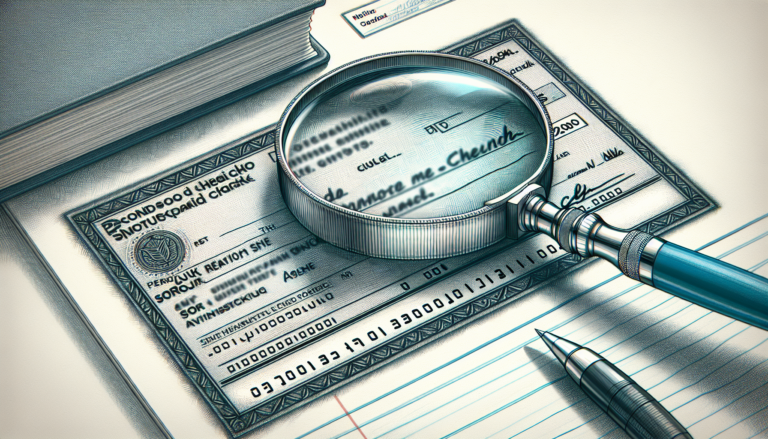Understanding how to locate your bank account number on a check is a crucial aspect of financial literacy. Your account number, along with your routing number, is essential for various banking transactions, such as setting up direct deposits or automatic payments. In this article, we will guide you through the process of finding your bank account number on a check and provide helpful tips for managing your banking information securely.
Understanding the Components of a Check
Before diving into locating your bank account number, it’s important to understand the different components that make up a check. A check contains several key elements, including the date, payee, amount, and signature line. However, the focus of this article will be on the numbers printed along the bottom edge of the check.
These numbers include the routing number, account number, and check number. Each of these numbers serves a specific purpose and is essential for processing financial transactions. By familiarizing yourself with these components, you’ll be better equipped to manage your banking activities effectively.
What is a Routing Number?
The routing number is a nine-digit code that identifies the financial institution associated with your checking account. This number is essential for directing electronic payments, such as direct deposits and automatic bill payments, to the correct bank. The routing number is typically located on the bottom left corner of your check.
It’s important to note that routing numbers are specific to the location of the bank where you opened your account. If your bank has branches in multiple states, each state may have a different routing number. Therefore, it’s crucial to use the correct routing number to ensure smooth transactions.
What is an Account Number?
Your account number is a unique identifier for your personal bank account. It is used to distinguish your account from others held at the same financial institution. The account number is usually located on the bottom of your check, directly to the right of the routing number.
Your account number can vary in length, but it is typically between 8 and 12 digits. This number is essential for setting up direct deposits, automatic payments, and other banking transactions. It ensures that funds are credited to or debited from the correct account.
What is a Check Number?
The check number is a unique identifier assigned to each individual check within your checkbook. It helps you keep track of the checks you’ve written and can be useful for budgeting and record-keeping purposes. The check number is usually the last set of numbers printed on the bottom right corner of your check.
When you write a check, it’s a good habit to record the check number, date, payee, and amount in your check register. This practice helps you stay organized and prevents confusion when reconciling your bank statements.
Where to Find the Bank Account Number on a Check
Now that you understand the different components of a check, let’s focus on locating your bank account number. Knowing where to find this important piece of information is crucial for setting up direct deposits, automatic payments, and other banking transactions.
Position of the Account Number on a Check
Your bank account number is typically printed on the bottom of your check, immediately to the right of the routing number. It is usually the second set of numbers from the left, sandwiched between the routing number and the check number.
To help you identify your account number easily, it’s useful to understand the standard format of the numbers on a check. From left to right, you’ll find the routing number, followed by your account number, and finally, the check number. This consistent format makes it simple to locate your account number whenever you need it.
Difference Between Routing Number and Account Number
It’s crucial to distinguish between your routing number and account number, as they serve different purposes. The routing number identifies your financial institution, while your account number is specific to your individual bank account.
When providing your banking information for direct deposits or automatic payments, you’ll typically need to supply both your routing number and account number. Double-check these numbers carefully to avoid any confusion or misdirected funds.
Importance of Routing and Account Numbers
Understanding the significance of your routing and account numbers is essential for managing your finances effectively. These numbers play a vital role in various banking transactions, such as setting up direct deposits and establishing automatic payments.
Setting Up Direct Deposits
Direct deposit is a convenient way to receive payments, such as your paycheck or government benefits, directly into your bank account. To set up direct deposit, you’ll need to provide your employer or the issuing agency with your routing and account numbers.
By using direct deposit, you can eliminate the need to physically deposit checks and gain faster access to your funds. It’s a secure and efficient method of receiving payments, as the money is electronically transferred directly into your account.
Establishing Automatic Payments
Automatic payments allow you to schedule recurring transactions, such as utility bills or subscription fees, to be deducted directly from your bank account. To set up automatic payments, you’ll need to provide the billing company with your routing and account numbers.
By automating your payments, you can ensure that your bills are paid on time, avoiding late fees and potential damage to your credit score. It’s a convenient way to manage your expenses and maintain a consistent payment schedule.
Accessing Your Bank Account Information
In today’s digital age, accessing your bank account information has never been easier. Most financial institutions offer online banking platforms and mobile banking apps that allow you to view your account details, including your routing and account numbers, from the comfort of your home or on the go.
Using Online Banking
Online banking provides a convenient way to manage your bank accounts through a secure digital platform. By logging into your bank’s website, you can view your account balances, transaction history, and account details, including your routing and account numbers.
Many online banking platforms also offer additional features, such as the ability to transfer funds between accounts, pay bills, and set up alerts for account activity. Familiarizing yourself with your bank’s online banking system can greatly simplify your financial management tasks.
Using a Mobile Banking App
Mobile banking apps bring the convenience of online banking to your smartphone or tablet. By downloading your bank’s mobile app, you can access your account information, including your routing and account numbers, anytime, anywhere.
Most mobile banking apps offer features similar to online banking, allowing you to check balances, view transaction history, and initiate transfers or payments. Some apps even provide mobile check deposit, enabling you to deposit checks by simply taking a photo with your smartphone.
Contacting Your Bank for Assistance
If you have any questions or concerns about your bank account information, don’t hesitate to reach out to your bank’s customer service center. They can provide guidance on locating your routing and account numbers, setting up direct deposits or automatic payments, and any other banking-related inquiries.
Many banks offer multiple channels for customer support, including phone assistance, email support, and live chat. Some even provide in-person assistance at local branches. Don’t be afraid to seek help when needed, as your bank’s customer service team is there to ensure a smooth and secure banking experience.
Security Tips for Managing Your Bank Account
While knowing your routing and account numbers is essential for various banking transactions, it’s equally important to protect this sensitive information from unauthorized access. Here are some security tips to keep in mind when managing your bank account:
Recognizing Phishing Attempts
Be cautious of unsolicited emails, text messages, or phone calls claiming to be from your bank and requesting your account information. These are often phishing attempts designed to trick you into revealing sensitive data. Remember, your bank will never ask for your account number, password, or PIN via email or text message.
If you receive a suspicious message, do not click on any links or provide any personal information. Instead, contact your bank directly using a trusted phone number or email address to verify the legitimacy of the request.
Managing Your Passwords
Create strong, unique passwords for your online banking accounts and avoid using the same password across multiple platforms. A strong password should include a combination of uppercase and lowercase letters, numbers, and special characters.
Consider using a password manager to generate and store complex passwords securely. Regularly update your passwords and never share them with anyone. Enable two-factor authentication whenever possible for an added layer of security.
Check Security Features
Familiarize yourself with the security features built into your checks. Many checks now include watermarks, microprinting, or other elements that make them more difficult to counterfeit. When writing a check, use a pen with permanent ink to prevent alterations.
If you suspect any fraudulent activity related to your checks, such as unauthorized transactions or missing checks, notify your bank immediately. They can assist you in placing a stop payment on the check and investigating any potential fraud.
Resources for Banking Education
If you’re looking to expand your knowledge of banking and personal finance, there are numerous resources available to help you along the way. From online articles to customer support services, you can find the information and guidance you need to make informed financial decisions.
Online Resources
The internet is a treasure trove of information on banking and financial literacy. Many reputable websites, such as those of financial institutions, government agencies, and personal finance blogs, offer articles, guides, and tools to help you better understand and manage your finances.
Take advantage of these online resources to learn about topics such as budgeting, saving, investing, and credit management. Many sites also provide calculators and templates to help you plan and track your financial goals.
Customer Support Options
Don’t underestimate the value of your bank’s customer support services. Many financial institutions offer personalized assistance and educational resources to help you navigate the world of banking.
Whether you have questions about your account, need help setting up online banking, or want advice on financial planning, your bank’s customer support team is there to help. They can provide guidance over the phone, through email, or in person at a local branch.
Some banks even offer educational workshops, webinars, or online courses on various financial topics. Take advantage of these resources to expand your knowledge and make informed decisions about your money.
In conclusion, understanding how to locate your bank account number on a check is a fundamental skill for managing your finances. By familiarizing yourself with the components of a check, knowing where to find your account information, and following best practices for security, you can navigate the world of banking with confidence. Remember, your bank is there to support you along the way, so don’t hesitate to reach out for assistance when needed.
See also:






